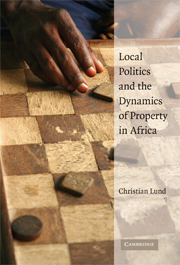Book contents
- Frontmatter
- Contents
- List of Maps, Figures, and Tables
- Acknowledgments
- Abbreviations
- Map 1 The Gold Coast, 1907
- Map 2 Regions of Ghana since 1983
- 1 Introduction
- 2 “This Situation Is Incongruous in the Extreme”: The History of Land Policies in the Upper Regions of Ghana
- 3 Who Owns Bolgatanga? The Revival of the Earthpriest and Emerging Tensions over Property
- 4 Seizing Opportunities: Chieftaincy, Land, and Local Administration
- 5 Settled Facts or Facts to Settle: Land Conflicts under Institutional Uncertainty
- 6 “Bawku Is Still Volatile”: Ethnopolitical Conflict and State Recognition
- 7 The Rent of Nonenforcement: Access to Forest Resources
- 8 Small Dams and Fluid Tenure
- 9 Conclusion
- References
- Index
3 - Who Owns Bolgatanga? The Revival of the Earthpriest and Emerging Tensions over Property
Published online by Cambridge University Press: 25 July 2009
- Frontmatter
- Contents
- List of Maps, Figures, and Tables
- Acknowledgments
- Abbreviations
- Map 1 The Gold Coast, 1907
- Map 2 Regions of Ghana since 1983
- 1 Introduction
- 2 “This Situation Is Incongruous in the Extreme”: The History of Land Policies in the Upper Regions of Ghana
- 3 Who Owns Bolgatanga? The Revival of the Earthpriest and Emerging Tensions over Property
- 4 Seizing Opportunities: Chieftaincy, Land, and Local Administration
- 5 Settled Facts or Facts to Settle: Land Conflicts under Institutional Uncertainty
- 6 “Bawku Is Still Volatile”: Ethnopolitical Conflict and State Recognition
- 7 The Rent of Nonenforcement: Access to Forest Resources
- 8 Small Dams and Fluid Tenure
- 9 Conclusion
- References
- Index
Summary
What made the “emergency” was the repeated public humiliation of the authorities; the simultaneous attacks upon royal and private property; the sense of a confederated movement which was enlarging its social demands.
E. P. Thompson, Whigs and HuntersIntroduction
Property rights in Bolgatanga and northern Ghana have been the object of much debate and struggle during the past three decades. A legal situation that was established in 1927 essentially remained in effect after independence. The Land and Native Rights Ordinance (Cap. 143) declared all lands in the Northern Territories, whether occupied or unoccupied, to be native lands and placed them under the control of the governor. When the 1979 Constitution divested the state of its trusteeship over most lands in the Northern and Upper regions, the need to address the question to whom these lands were to be given became acute. The new legal situation provided an opportunity for reassessing the past, resettling old accounts, reasserting belonging in terms of prerogatives and jurisdictions, and renegotiating ownership to land. Chiefs and earthpriests intensified their competition over the control of the land.
This chapter deals with the history of landownership in Bolgatanga as a story of competing claims to customary authority and clashes between public and private interests in land. The chapter starts with a brief glimpse into a report of the lands commissioner, from 1948, which illustrates the evolutionary perspective on customary land tenure promoted by both anthropologists and administrators during the colonial period.
- Type
- Chapter
- Information
- Local Politics and the Dynamics of Property in Africa , pp. 47 - 67Publisher: Cambridge University PressPrint publication year: 2008

